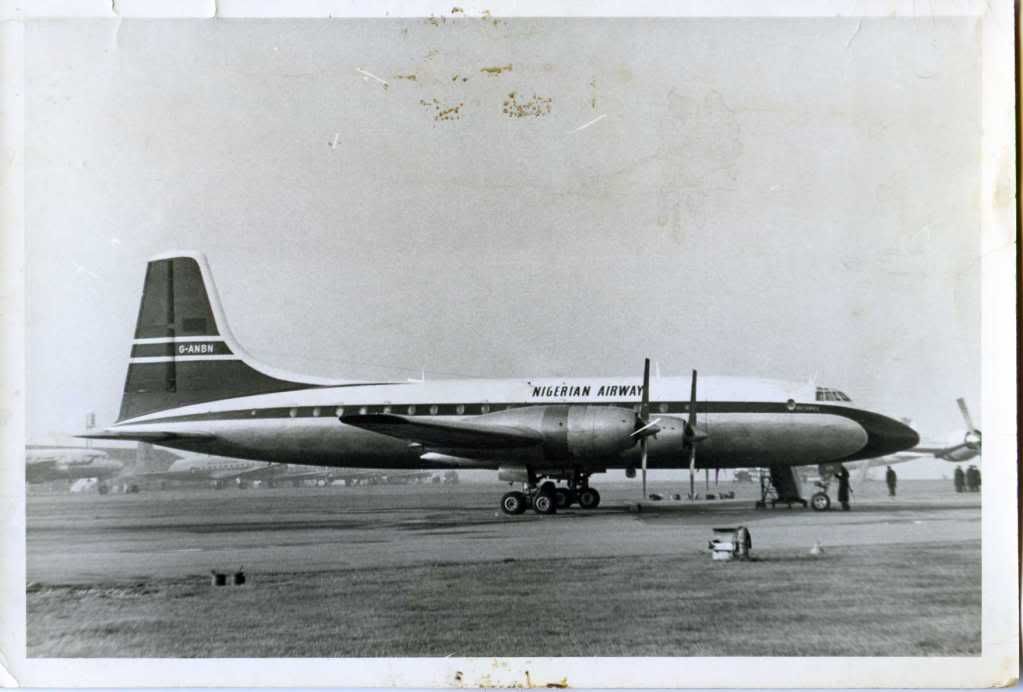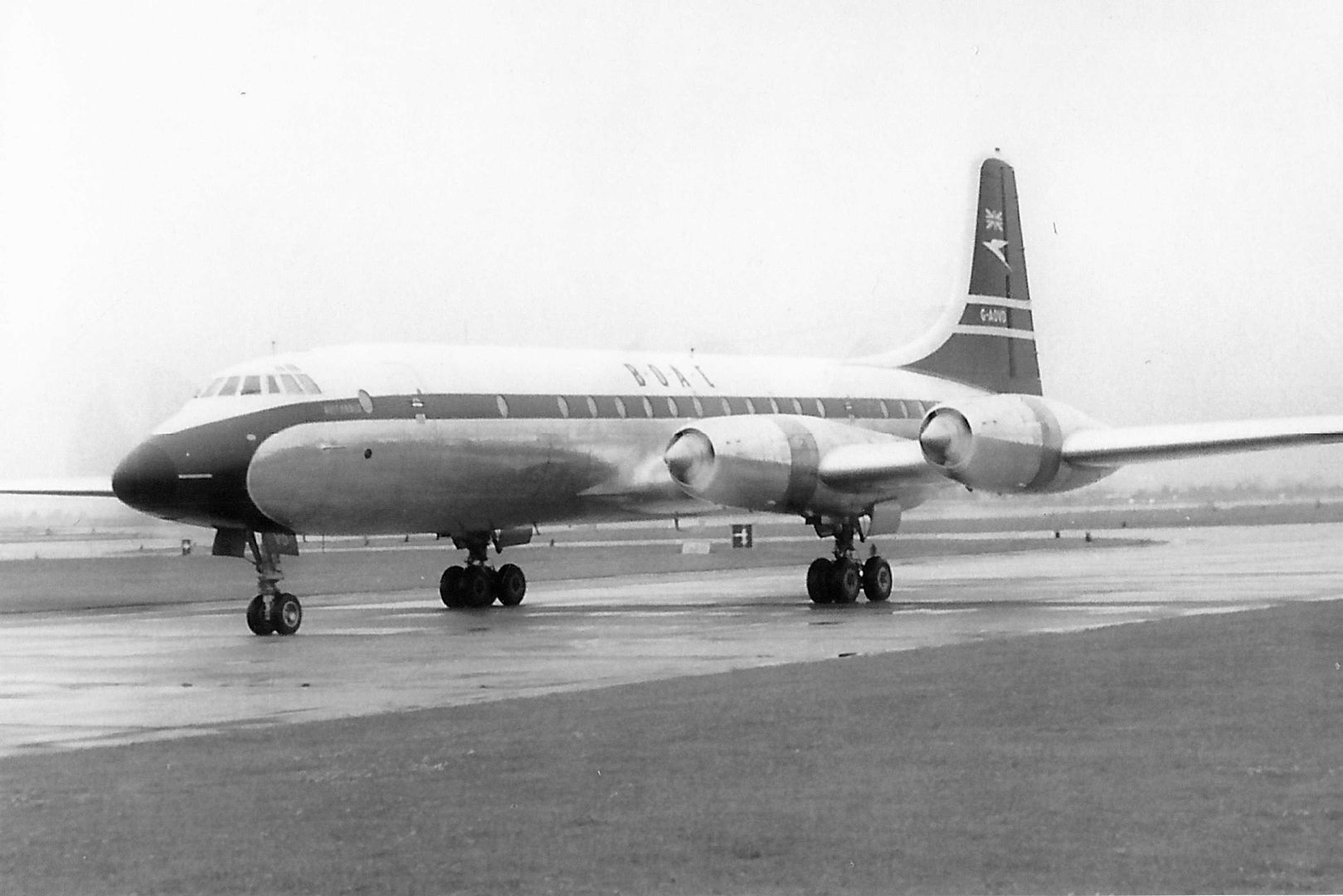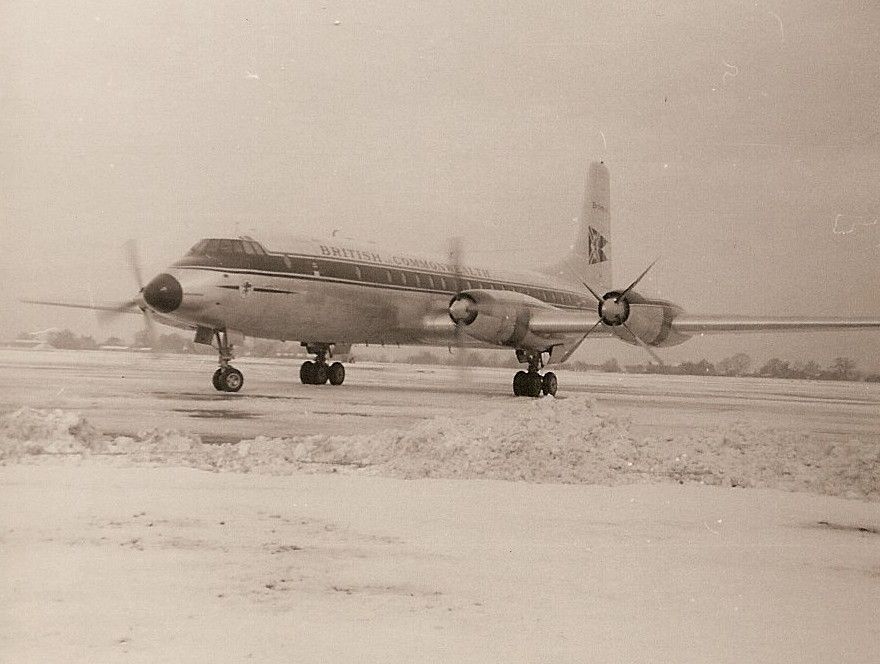Post by flyboy on Apr 6, 2016 13:32:34 GMT
THE BRISTOL BRITANNIA
During World War II British aircraft production had understandably concentrated on mainly bomber and fighter aircraft needed for the war effort. In 1943 a committee under the leadership of Lord Brabazon of Tara was formed to investigate the future need for civilian transport aircraft once the war drew to a conclusion.
Thus, the Brabazon Committee as it was known, called for a number of designs to be submitted to meet envisaged civil aviation requirements in various different classes. The Type III was to meet BOAC's medium range routes and specification C2/47 called for an airliner carrying 48 passengers and to be powered by the Bristol Centaurus piston engine or the under development Napier Nomad compound engine. It also noted that turboprop options would also be considered but being very new Bristol's couldn't guarantee the performance of their turboprop engine.
BOAC were looking for a new aircraft and Bristol's put forward a design for consideration. In 1948 the go ahead was given by the Ministry of Supply for three prototypes to be built, the Mk.1 with Centaurus 662 piston engines and the following two aircraft, to be designated MK.2, were to be convertible to the Bristol Proteus turboprop engine that was then under development.
In October 1947 Bristol's had settled on a Centaurus piston engined design with an all up weight of 10300lbs (47000kg) and a payload of 13300lbs (6000kg). This would be enough, with a 48 seat limit to meet the Karachi-Cairo route requirement with sufficient fuel being carried.
On 5th July 1949 the Ministry of Supply ordered 5 prototypes with an agreement that BOAC would contract for an additional 25 production aircraft. They placed an order on July 28th for the 25 aircraft initially to be Centaurus engined but on the understanding that they would be refitted with Bristol Proteus engines once they became available. However, in 1948 the type 175 design, had been revised to carry 74 passengers with a longer wing as a long-haul Empire and trans-Atlantic version. BOAC then decided that only a Proteus engine would be considered. The 175 project was then made subject to the engine passing a 150 hour type performance test.
In April 1950 the name 'Britannia' was chosen for the aircraft and it was given the designation Bristol 101 in the 100 series. The first two prototypes were fitted with the early Proteus 625 engine and 'Bill' Pegg, Bristol's Chief Test Pilot took the prototype, G-ALBO up for it's first flight on August 16th 1952. It proved to be an eventful maiden flight, the flight deck filled with smoke, there were quite severe control problems and on approach to land the main undercarriage failed to fully deploy until the last minute. One can only imagine that the crew were very pleased to finally find themselves safely on the ground in one piece!
The problems were, however, quickly solved and the aircraft was cleared to perform at the 1952 Farnborough Airshow where it received praise for it's quietness.
In December 1953, the second prototype G-ALRX suffered an engine fire while on a test flight and the pilot was forced to crash land the aircraft on mud flats in the Severn Estuary. Coupled with this problems being experienced with engine inlet icing caused further delay and the introduction into service was further delayed.
It had been expected that BOAC would start to operate their order for 25 aircraft initially starting in 1954, but due to the crashes of two Comet 1 jet airliners the Air Ministry demanded further Britannia testing which was to further delayed the in-service date.
Bristol's developed the airliner further with both the 200 and 300 series but it was the 300LR (long range) was the version that interested BOAC for use on the service between London and Sydney. The price being paid for a series 100 aircraft at this time (1955) was around £768,000 each.
Other airlines including Qantas, El Al and Canadian Pacific Airlines expressed interest in the possible purchase of the aircraft although the unscheduled replacement of 49 engines and 16 engine failures experienced in just eight months of operational trials might well have dampened any enthusiasm. It wasn't until February 1957 that the aircraft finally entered service, about two years later than had been expected.
Canadair of Canada were issued with a license in 1954 to build the CL28 Argus and CL44 Yukon. The Argus, with 33 being built was equipped for maritime and anti-submarine duties while the Yukon was a troop transport and freighter, although the Royal Canadian Air Force operated it as a passenger carrying model only. Both types had extensively modified fuselages with the Yukon being powered by Rolls-Royce Tyne engines.
Loftleider and Flying Tiger Line were operators, with the latter operating the CL44D4 version with a swing tail allowing easier cargo loading especially of large objects. Further development by Conroy's produced the one off Conroy Skymonster , or 'Guppy' as it was better known with a much enlarged fuselage built by Aero Spacelines.
******************************************
SPECIFICATION
Series 310
Crew 4-7
Capacity 139 passengers (coach class)
Length 124' 3" (37.88m)
Wingspan 142' 3" (43.36m)
Height 37' 62" (11.43m)
Weight Empty 86400lb (38500kg)
Weight Max T/O 185000 (84000kg)
Power 4x Bristol Proteus 765 turboprops 4450 ehp (3320kW) each.
Max Speed 397mph (345 kts)
Cruise 357mph (310 kts)
Range 4430 miles (7129km)
Service Ceiling 24000ft (7300m)
********************************************
DEVELOPMENT VARIATIONS : MODEL 175 BRITANNIA
MkI 2x prototypes to be p2xowered by Centaurus 662 piston engines - Not built
Mk2 2x prototypes to be powered by either Centaurus662 piston engines or Proteus turboprops -Not built.
Series 100. in all 74 passenger aircraft built with 4x Bristol Proteus turboprop engines.
Series 101. 2x prototypes Proteus 625 engines, re-engine with Proteus 755's. 1st prototype G-ALBO used
to develop the Bristol Orion engine in 1956 and Proteus 765 in 1957.
Series 102 25x production aircraft for BOAC - last 10 cancelled in favour of 300 series, 15 built.
Series 200 proposed cargo variant - none built.
Series 250 mixed passenger/freight version.
Series 252 Ordered for Ministry of Supply for lease to charter operators. Delivered to the Royal Air Force
as the C2 with strengthened heavy duty forward floor area and freight door. 3 built.
Series 253 Passenger/freight version for RAF designated Britannia C1, capacity 115 troops or cargo,
20 built. When sold for civil use designated as Series 253F.
Series 300 Longer fuselage, 139 passengers with medium fuel capacity.
Series 301 Company prototype, one built.
Series 302 10x built for BOAC but cancelled, 2 delivered to Aeronaves de Mexico.
Series 305 5x long-range, Belfast built series 302's - cancelled.
Series 306 1x ex 305 leased to El Al, later to become series 307.
Series 307 2x to Air Charter one in 1958 and one in 1959, ex BOAC later to British United Airlines.
Series 307F Freight conversion of Series 307.
Series 308 2x Series 305's renumbered and to Transcontinental SA.
Series 308F 1960's freight conversion of the 308 for British Eagle, both converted.
Series 309 One former Series 305 leased to Ghana Airways.
Series 310 As 305 but with strengthened skin and undercarriage. Long rang fuel originally
known as the 300LR.
Series 311 1x prototype (300LR)
Series 312 18x production aircraft for BOAC.
Series 312F 1960's conversion of Series 312 to freighter - 5 converted.
Series 313 4x for El Al.
Series 314 6x for Canadian Pacific Airlines.
Series 317 2x for Hunting-Clan, 124 passenger troop configuration.
Series 318 4x for Cubana de Aviacion, delivered December 1958, later 1 to Cunard Eagle
on lease 1960-1961, then to CSA in 1962.
Series 319 Last production Britannia sold to Ghana Airways ,was modified ex 310/311 series.
Series 320 2x built and completed as Series 324 after Trans World Airlines did not conclude order.
Series 324 2x Series 320's for Canadian Pacific not taken up - sold to
Cunard Eagle Airways in 1961.
******************************************
BLACKBUSHE BRITANNIA KNOWN MOVEMENTS :
Listed below are the known visiting Britannia's noted at Blackbushe over the years. The date is shown followed by the reason for the visit when known and indicates the operator at the time when the same aircraft visited with different operators. I feel sure that there were many other visits by the type apart from those recorded which rely mainly on well worn enthusiasts notebooks that have survived over the years.
Some abbreviations used: BOAC = British Overseas Airways Corporation, ILS=Instrument Landing System,
runs = approaches ct = circuit training, AW = Airways, LHR = London Heathrow Airport, divn = diversion, w/o = written off,
c/n = construction number.
CF-CPE 13517 Canadian Pacific Airlines 6.11.59 ILS runs.
CU-P760 13437 Cubana 14.5.59 ILS runs.
G-ALBO 12873 Bristol Aircraft 15.1.56
G-ANBA 12902 BOAC/Nigerian Airways 2.5.58,1.3.59,4.3.59 BOAC ct,
4.5.59 Nigerian AW ct, 13.3.60 BOAC ct.
G-ANBB 12903 --------//-------- 10.7.57 BOAC, 4.6.59 Nigerian AW ct.
G-ANBC 12904 BOAC 15.4.57 ct, 28.9.57, 29.11.58, 10.3.60 ct.
G-ANBD 12905 --//-- 29.2.56 ct, 30.11.58.
G-ANBE 12906 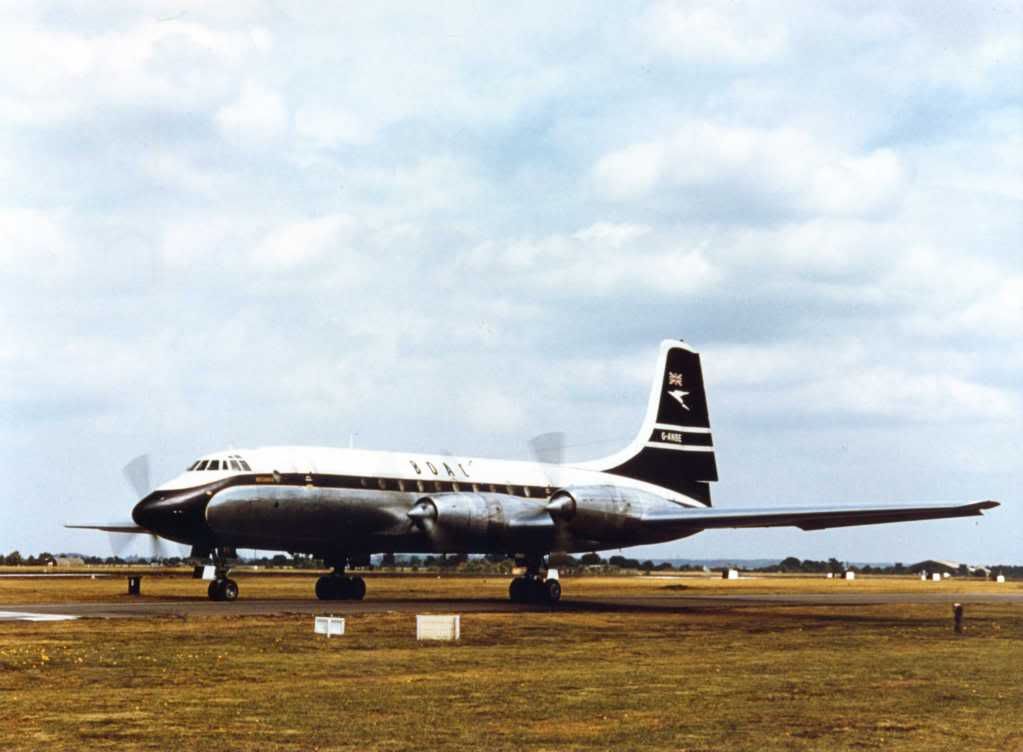
G-ANBE 12906 --//-- 3.7.56 ct.
G-ANBF 12907 --//-- 30.5.56 ct.
G-ANBH 12909 --//-- 13.6.58, 7.11.59 LHR divn.
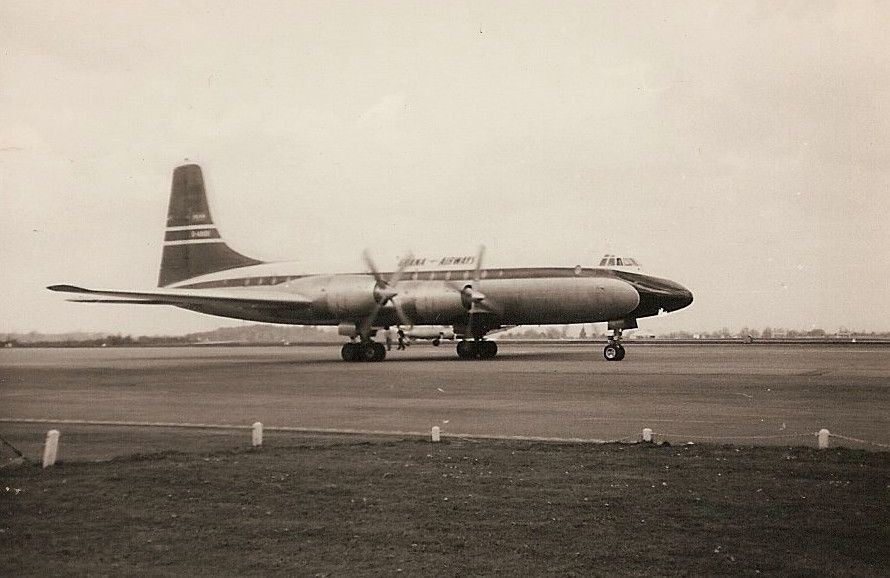
G-ANBI 12910 BOAC/Ghana Airways 14.4.60 & 15.4.60 both Ghana AW.
G-ANBJ 12911 BOAC 13.3.57 ct, 15.12.59 LHR divn.
G-ANBK 12912 --//-- 12.5.57 ct.
G-ANBL 12913 --//-- 10.1.59.
G-ANBM 12914 --//-- 9.4.58.
G-ANBN 12915 BOAC/Nigerian AW 6.6.57 BOAC, 7.11.59 Nigerian AW.
G-ANBO 12916 BOAC 14.1.58.
G-ANCA 12917 Bristol Aircraft 13.4.57 series 300 demonstrator,
crashed 6.11.57 w/o.
G-AOVA 13207 BOAC 00.57 1st BOAC Britannia 175-300 series.
G-AOVB 13230 --//-- 17.4.57 ct, 22.9.57 ct.
G-AOVC 13231 --//-- 23.11.57, 31.8.58.
G-AOVE 13236 --//-- 00.57, 11.1.58, 14.1.58, 20.9.58.
G-AOVF 13237 --//-- 9.5.58 ct, 4.3.59 ct.
G-AOVH 12925 --//-- 04.58.
G-AOVJ 13413 --//-- 14.3.59,15.3.59 ct.
G-AOVL 13428 --//-- 25.1.59.
G-AOVR 13429 --//-- 29.12.58.
G-APLL 12908 --//-- 12.12.59.
G-APNA 13425 British and Commonwealth 21.4.59, 6.5.59, 3.6.59, 17.1.60,
23.1.60 all flights ct.
G-APNB 13426 ---------//------------ 3.1.59 ct.
G-APYY 13432 Eagle 24.4.60.
LV-PPJ 12922 Transcontinental SA 28.11.59 ILS runs.
LV-PPL 12923 -----//------- 5.12.59 ILS runs.
XA-MEC 12918 Aeronaves de Mexico 27.10.57 ILS runs.
XA-MED 12919 -----//------- 14.12.57 ILS runs.
RAF:
XL635 13397 Royal Air Force 8.7.59 ILS runs, 9.9.59.
XL636 13398 ----//---- 26.2.60 ILS runs.
XL638 13400 ----//---- 29.4.60, 1.5.60 & 2.5.60.
XL658 13455 ----//---- 31.3.60.
XM518 13512 ----//---- 31.3.60.
XN398 13451 ----//---- 27.2.60 & 29.3.60 ILS runs.
OTHER MILITARY:
Argus CL28.
20723 c/n 14 Royal Canadian Air Force 26.6.59.
*************************************
BRITANNIA GENERAL NOTES:
The G-AN__ registered aircraft (c/n's 12902-12916) were Series -102 aircraft initially for BOAC.
12908 G-ANBG was re-registered G-APLL by BOAC and eventually went to BKS Air Transport.
12917 G-ANCA was the Series 300 prototype and first flight was 31.7.56. W/O in crash Downend 6.11.57.
13207 G-AOVA initially to BOAC, then leased to Ghana Airways 9G-AAH, British Eagle International 1965.
13230 G-AOVB initially to BOAC, then British Eagle International15.10.63 then to Argentina as LV-JNL.
13231 G-AOVC initially to BOAC, then British Eagle International May 64, Donaldson International 1969.
13233 13234, 13235, 13428 also all operated by British Eagle International.
13397 RAF sold Sept 1975 to Young Air Cargo as OO-YCA.
13398 RAF sold May 1976 to Young Air Cargo as OO-YCE.
13400 RAF crashed Khormaksar, Yemen 10.12.67 into sea on landing. Obstruction and blown up.
....................................................
Credits: Internet
Wikipedia
rzjets
rj and his sources - don't miss his book when published.
PB for the photographs.
Complete.

